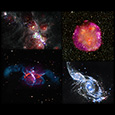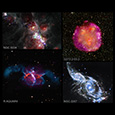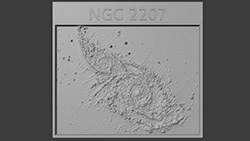CXC Home | Search | Help | Image Use Policy | Latest Images | Privacy | Accessibility | Glossary | Q&A
A Quartet of Autumn Images:
These four images contain X-rays from Chandra along with data from other telescopes. The images are the star-forming region NGC 6334, supernova remnant G272.2-0.3, interacting spiral galaxies NGC 2207 and IC 2163, as well as R Aquarii, which hosts an orbiting pair of stars. The phenomenon of pareidolia allows people to see familiar patterns or shapes in data, including those collected from space.
1
NGC 6334Credit: X-ray: NASA/SAO/CXC; Infrared: NASA/JPL/CalTech/Spitzer; Image Processing: NASA/CXC/SAO/J. Schmidt
For many, nothing evokes fall more than fallen leaves. In this view of NGC 6334, glowing pockets of dust and gas in the nebula resemble leaves that have been picked up by a wind gust. This region is actually home to strong winds blowing from the young stars that have formed there. This image contains X-ray data from Chandra (blue, green, and yellow) that shows the effects of these winds, which have been combined with infrared data from the now-retired Spitzer Space Telescope (red, brown), which shows the dust and gas that fuels the growing stars.
2
SNR G272.2-03.2Credit: X-ray: NASA/CXC/SA0; Optical: NOIRLab/DECaPS2; Image Processing: NASA/CXC/SAO/L. Frattare
Born after a violent explosion of a star, this cosmic gourd is the supernova remnant G272.2-03.2. X-ray observations (orange and magenta) from Chandra provide evidence that G272 is the result of a Type Ia supernova explosion, where a white dwarf star pulls material from a companion star until it triggers a thermonuclear explosion and obliterates the star. The inside of the “pumpkin” is superheated gas that is filling the space cleared out by the explosion as it moves outward.
3
R AquariiCredit: X-ray: NASA/CXC/SAO; ESA/XMM-Newton; Optical HST: NASA/ESA/STScI; Optical Ground: Deep Space Remote observatories/B. Fera and S. Mandel; ESO/VLT; Image Processing: NASA/CXC/SAO/L. Frattare
Multiple telescopes teamed up to capture an image that looks like a cozy sweater with fuzzy arms. X-rays from Chandra and ESA’s XMM-Newton (purple), optical light data from Hubble and the Very Large Telescope in Chile (orange, red, and violet), and an optical image from astrophotographers Bob Fera and Steve Mandel (deep blue) combine to reveal R Aquarii. Nestled within the cozy ‘body’ of R Aquarii is a pair of stars where a white dwarf is pulling material from a much larger red giant companion. When enough material accumulates on the surface of the white dwarf, it triggers an outburst that sends a jet out into space. Over time, these jets twist and loop around each other weaving the structure seen today.
4
NGC 2207 and IC 2163Credit: X-ray: NASA/CXC/SAO; Infrared: NASA/ESA/CSA/STScI/Webb; Image Processing: NASA/CXC/SAO/L. Frattare
A cornucopia is a horn-shaped basket that traditionally carries fruits and vegetables. There is nothing edible in this pair of galactic cornucopias but there are a bounty of stars, dust, and other ingredients than make up these two spiral galaxies, known as NGC 2207 (right) and IC 2163 (left), that we see face-on. This view of NGC 2207 and IC 2163 takes a James Webb infrared image (white, gray, and red) and adds the X-ray view from Chandra (blue). Together, it is quite an eye-catching result.
Tactile Products
This set of four tactile plates shows physical relief maps based on X-ray, infrared and/or optical data. The plates feature four images surrounding a fall theme.
1
3D Printable Files: NGC 6334 (3D Print Credit: NASA/CXC/A. Jubett, using software by Tactile Universe/N. Bonne & C. Krawczyk & Blender)
NGC 6334 is a massive nebula and star-forming region. In this plate of Chandra X-ray and Spitzer infrared data, scores of pointed young stars, depicted as tiny specs, rise above all other features. The specs are clustered near the center of the image, but extend to the edges of the frame in streaks. Partially masking the specs are tendrils of clouds; strong winds of dust and gas blowing from the still-forming stars.
2
3D Printable Files: SNR G272.2-03.2 (3D Print Credit: NASA/CXC/A. Jubett, using software by Tactile Universe/N. Bonne & C. Krawczyk & Blender)
A supernova remnant called G272.2-3.2 is featured on this plate with X-ray data from Chandra and optical data from NOIRLab. Here, a white dwarf star has pulled material from a companion star, triggering a thermonuclear explosion. What remains is a giant ball of superheated gas, set against a densely-packed field of distant stars and galaxies. In this plate, the ball of gas is a mottled sphere with patchy clumps at the outer edges.
3
3D Printable Files: R Aquarii (3D Print Credit: NASA/CXC/A. Jubett, using software by Tactile Universe/N. Bonne & C. Krawczyk & Blender)
R Aquarii is a symbiotic binary star. In this plate, a white dwarf star pulls material from a much larger red giant companion, sending looping jets of matter into space. In this composite plate with X-ray data from Chandra and XMM as well as optical data from Hubble, the VLT, and astrophotographers, the resulting structure resembles a cozy sweater with wooly arms opened wide.
4
3D Printable Files: NGC 2207 and IC 2163 (3D Print Credit: NASA/CXC/A. Jubett, using software by Tactile Universe/N. Bonne & C. Krawczyk & Blender)
This plate depicts a pair of colliding spiral galaxies in X-ray data from Chandra, and infrared data from Webb. Both spirals are shown face on, with the smaller of the two galaxies, IC 2163, at the upper left of the larger galaxy, NGC 2207, which dominates the center and lower right of the plate. Both galaxies have long, spiraling arms, dotted with specs. Toward the upper left, the curving arms overlap, and bend toward their neighbors’ core.
Return to: Before Fall Leaves, See Seasonal Offerings from NASA's Chandra (November 24, 2025)





















